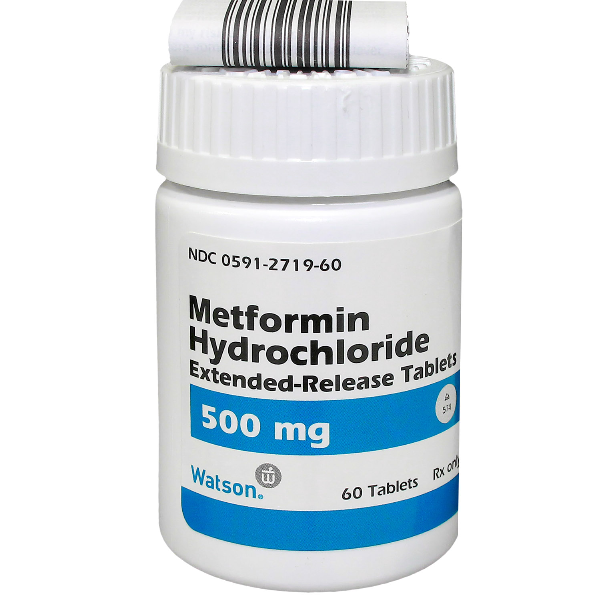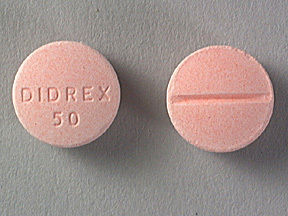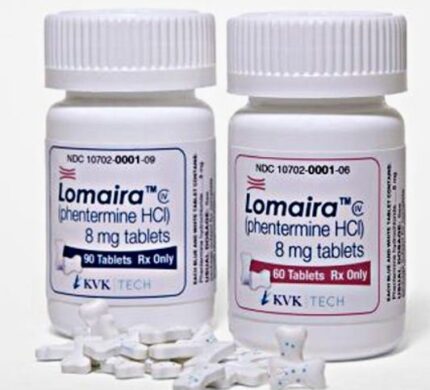What is metformin hcl?
Metformin (also known as metformin hydrochloride or metformin HCl) is a medication used to treat type 2 diabetes. It works by decreasing the amount of glucose produced by the liver and improving the body’s response to insulin. This results in lower blood sugar levels.
Metformin is usually taken orally as a tablet, and it is typically taken with meals to reduce the risk of gastrointestinal side effects. It is often prescribed as an initial treatment for type 2 diabetes, either alone or in combination with other medications.
In addition to its use in treating type 2 diabetes, metformin is sometimes used off-label for other conditions, such as polycystic ovary syndrome (PCOS) and gestational diabetes.
Like all medications, metformin can cause side effects. Common side effects include gastrointestinal symptoms such as nausea, vomiting, diarrhea, and abdominal discomfort. These side effects are often mild and improve with time, but in some cases, they may be severe enough to require discontinuing the medication. Metformin may also increase the risk of a rare but serious condition called lactic acidosis, particularly in people with kidney or liver problems.
If you are prescribed metformin, it is important to follow your doctor’s instructions carefully and to let them know about any side effects you experience.
How to use metformin.
Before you start taking metformin and each time you get a refill, be sure to read the Patient Information Leaflet. If you have any questions, consult your clinician or pharmacist.
Take metformin by mouth as directed by your licensed medical professional, usually one to three times per day with meals. There are different formulations of metformin, so be sure to take it exactly as prescribed. Unless directed otherwise by your licensed medical professional, drink plenty of fluids while taking this medication.
The dosage you’ve been prescribed is based on your medical condition, other conditions you’re managing and your response to treatment. Tell your clinician and pharmacist about all the products you use (including prescription and nonprescription drugs, as well as herbal products). Your licensed medical professional may tellyou to start this medication at a low dose and gradually increase your dose, in order to reduce your risk of side effects, such as upset stomach . Follow your licensed medical professionals instructions carefully.
To get the most benefit from your metformin, take it regularly at the same time(s) each day.
If you are already taking another medication to help manage your diabetes, follow your licensed medical professionals directions carefully for stopping or continuing the old drug when starting metformin.
While taking metformin, check your blood sugar level regularly as directed by your licensed medical professional. Keep track of the results, and share them with your licensed medical professional. Be sure to tell them if your blood sugar measurements are too high or too low, as your dosage or treatment may need to be adjusted based on your condition.
It’s important to be aware of possible side effects before you start taking a medication. Here are the listed side effects for this drug.
Nausea, vomiting, stomach upset, diarrhea, weakness, or a metallic taste in the mouth may occur. If any of these effects persist or worsen, tell your doctor or pharmacist promptly. If stomach symptoms return later (after taking the same dose for several days or weeks), tell your doctor right away. Stomach symptoms that occur after the first days of your treatment may be signs of lactic acidosis.
Remember that your doctor has prescribed this medication because he or she has judged that the benefit to you is greater than the risk of side effects. Many people using this medication do not have serious side effects.
Metformin does not usually cause low blood sugar (hypoglycemia). Low blood sugar may occur if this drug is prescribed with other diabetes medications. Talk with your doctor or pharmacist about whether the dose of your other diabetes medication(s) needs to be lowered.
Symptoms of low blood sugar include sudden sweating, shaking, fast heartbeat, hunger, blurred vision, dizziness, or tingling hands/feet. It is a good habit to carry glucose tablets or gel to treat low blood sugar. If you don’t have these reliable forms of glucose, rapidly raise your blood sugar by eating a quick source of sugar such as table sugar, honey, or candy, or drink fruit juice or non-diet soda. Tell your doctor about the reaction right away. Low blood sugar is more likely if you drink large amounts of alcohol, do unusually heavy exercise, or do not consume enough calories from food. To help prevent low blood sugar, eat meals on a regular schedule, and do not skip meals. Check with your doctor or pharmacist to find out what you should do if you miss a meal.
Symptoms of high blood sugar (hyperglycemia) include thirst, increased urination, confusion, drowsiness, flushing, rapid breathing, and fruity breath odor. If these symptoms occur, tell your doctor right away. Your doctor may need to adjust your diabetes medication(s).
Stop taking this medication and tell your doctor right away if this very serious side effect occurs: lactic acidosis (see Warning section).
A very serious allergic reaction to this drug is rare. However, get medical help right away if you notice any of the following symptoms of a serious allergic reaction: rash, itching/swelling (especially of the face/tongue/throat), severe dizziness, trouble breathing.
This is not a complete list of possible side effects. If you notice other effects not listed above, contact your doctor or pharmacist.
It’s also important to be aware of precautions and warnings around taking this medication.
Before taking this medication, tell your doctor or pharmacist if you are allergic to metformin; or if you have any other allergies. This product may contain inactive ingredients, which can cause allergic reactions or other problems. Talk to your pharmacist for more details.
Before using this medication, tell your doctor or pharmacist your medical history, especially of: severe breathing problems (such as obstructive lung disease, severe asthma), blood problems (such as anemia, vitamin B12 deficiency), kidney disease, liver disease.
Before having surgery or any X-ray/scanning procedure using iodinated contrast, tell your doctor or dentist about all the products you use (including prescription drugs, nonprescription drugs, and herbal products). You may need to stop this medication for a short time for the surgery/procedure. Ask your doctor or dentist for instructions before your surgery/procedure.
You may experience blurred vision, dizziness, or drowsiness due to extremely low or high blood sugar. Do not drive, use machinery, or do any activity that requires alertness or clear vision until you are sure you can perform such activities safely.
Limit alcohol while using this medication because it can increase your risk of lactic acidosis and developing low blood sugar.
High fever, ‘water pills’ (diuretics such as hydrochlorothiazide), too much sweating, diarrhea, or vomiting may cause loss of too much body water (dehydration) and increase your risk of lactic acidosis. Stop taking this medication and tell your doctor right away if you have prolonged diarrhea or vomiting. Be sure to drink enough fluids to prevent dehydration unless your doctor directs you otherwise.
It may be harder to control your blood sugar when your body is stressed (such as due to fever, infection, injury, or surgery). Consult your doctor because increased stress may require a change in your treatment plan, medications, or blood sugar testing.
Older adults may be at greater risk for side effects such as low blood sugar or lactic acidosis.
During pregnancy, this medication should be used only when clearly needed. Discuss the risks and benefits with your doctor. Your doctor may direct you to use insulin instead of this product during your pregnancy. Follow your doctor’s instructions carefully.
Metformin can cause changes in the menstrual cycle (promote ovulation) and increase the risk of becoming pregnant. Consult your doctor or pharmacist about the use of reliable birth control while using this medication.
Metformin passes into breast milk in small amounts. Consult your doctor before breast-feeding.
Store metformin at room temperature, away from moisture and light. Do not store metformin in the bathroom. Keep metformin, and all medications, away from pets and children.
Unless instructed to do so, do not pour metformin or any medication down a drain or flush them down the toilet. Ask your pharmacist or local waste disposal company how to properly discard metformin once it is expired or no longer needed.
Drug interactions can increase your risk for serious side effects or change how your medications work. This document does not contain all possible drug interactions. Keep a list of all the products you use (including prescription and nonprescription drugs, as well as herbal products) and share it with your clinician and pharmacist. Do not start, stop, or change the dosage of metformin or any medicines you take without your licensed medical professional’s approval.
Beta-blocker medications, like propranolol or metoprolol, and glaucoma eye drops, such as timolol, may prevent the pounding or fast heartbeat you would usually feel when your blood sugar falls too low (hypoglycemia). Other symptoms of low blood sugar, like hunger, sweating or dizziness are unaffected by these drugs.
Your blood sugar can be difficult to control, because many drugs can affect it. Talk with your clinician or pharmacist about how a medication may affect your blood sugar before you start, stop, or change it. Check your blood sugar regularly as directed and share the results with your licensed medical professional. Tell them right away if you have symptoms of high or low blood sugar. (See Side Effects.) Your licensed medical professional may need to adjust your diabetes medication, diet or exercise program.
Metformin overdose
Symptoms of metformin overdose can include: rapid breathing, severe drowsiness, slow/irregular heartbeat and/or severe nausea/diarrhea/vomiting.
Overdose can cause lactic acidosis.
Call 911 if someone has overdosed and has serious symptoms such as passing out or trouble breathing. Otherwise, call a poison control center immediately. US residents can call their local poison control center at 1-800-222-1222. Canada residents can call a provincial poison control center.
















Reviews
There are no reviews yet.